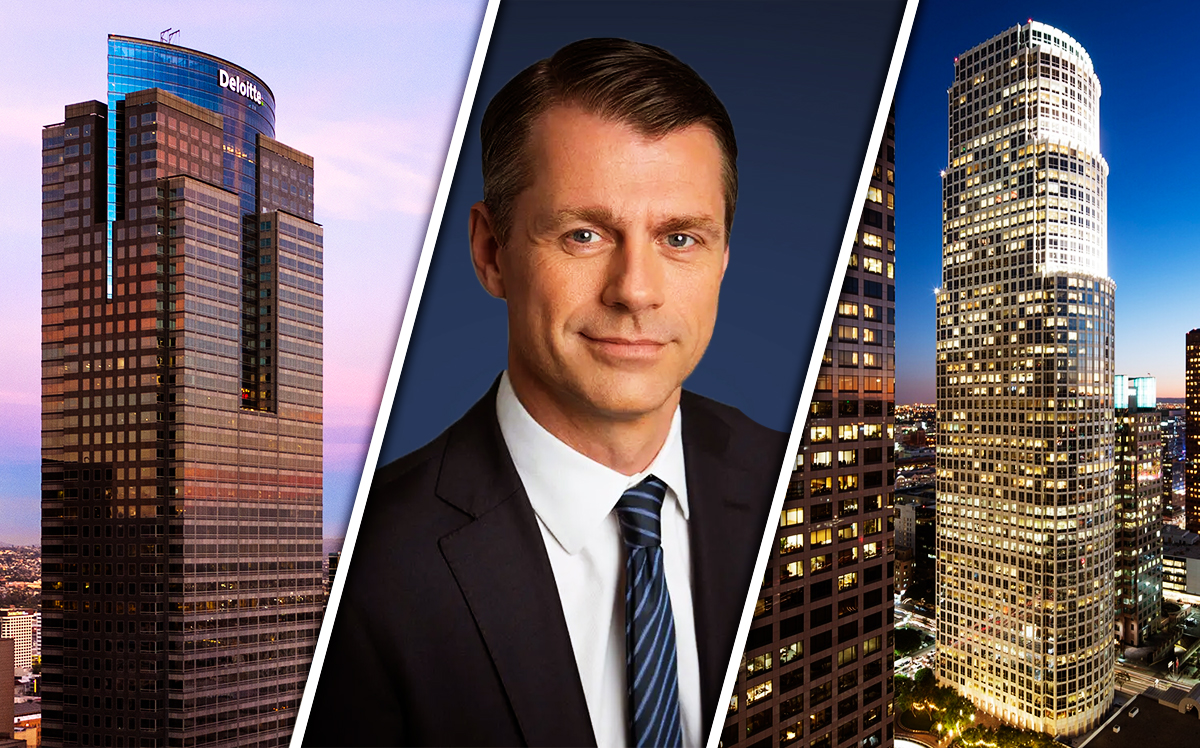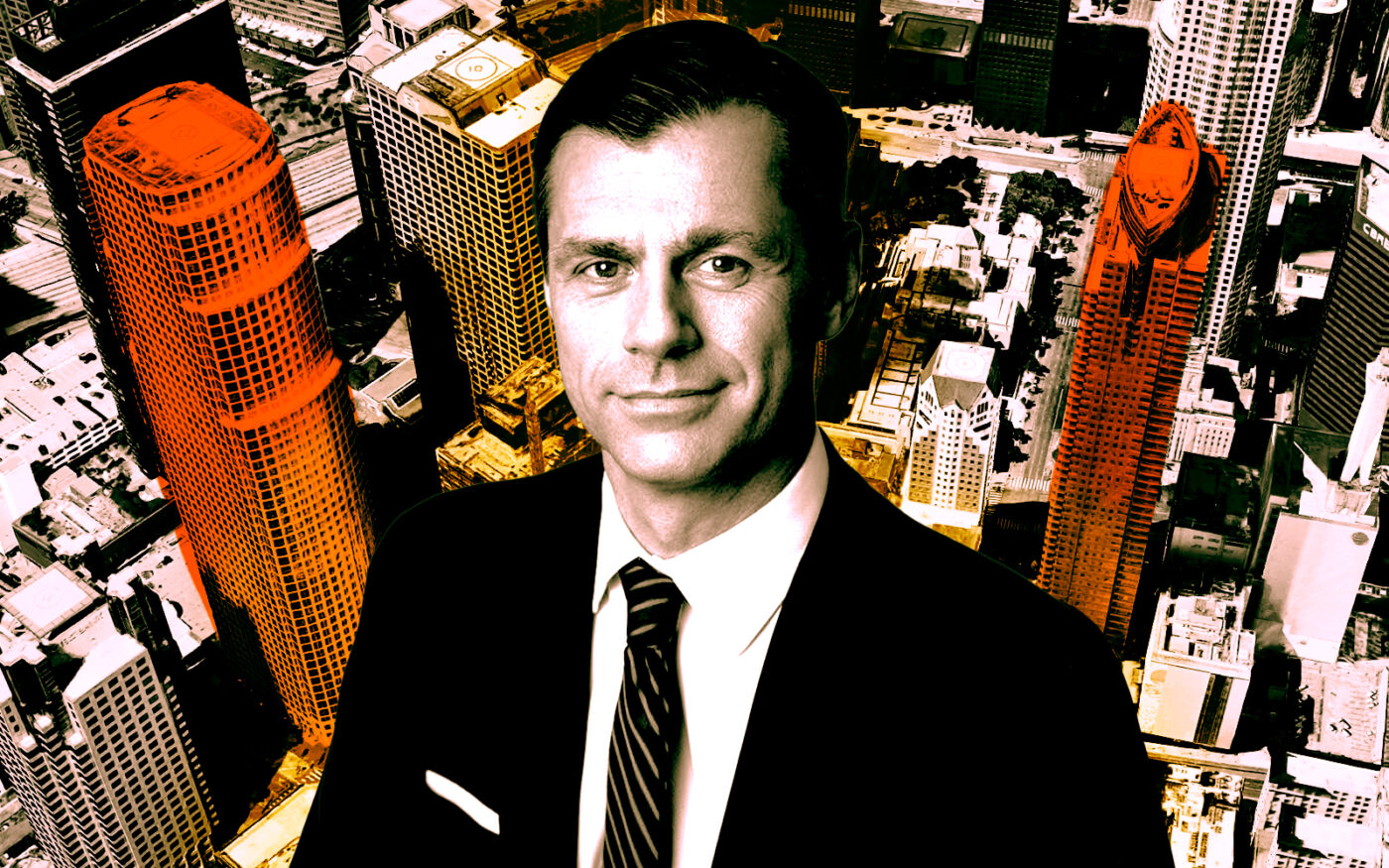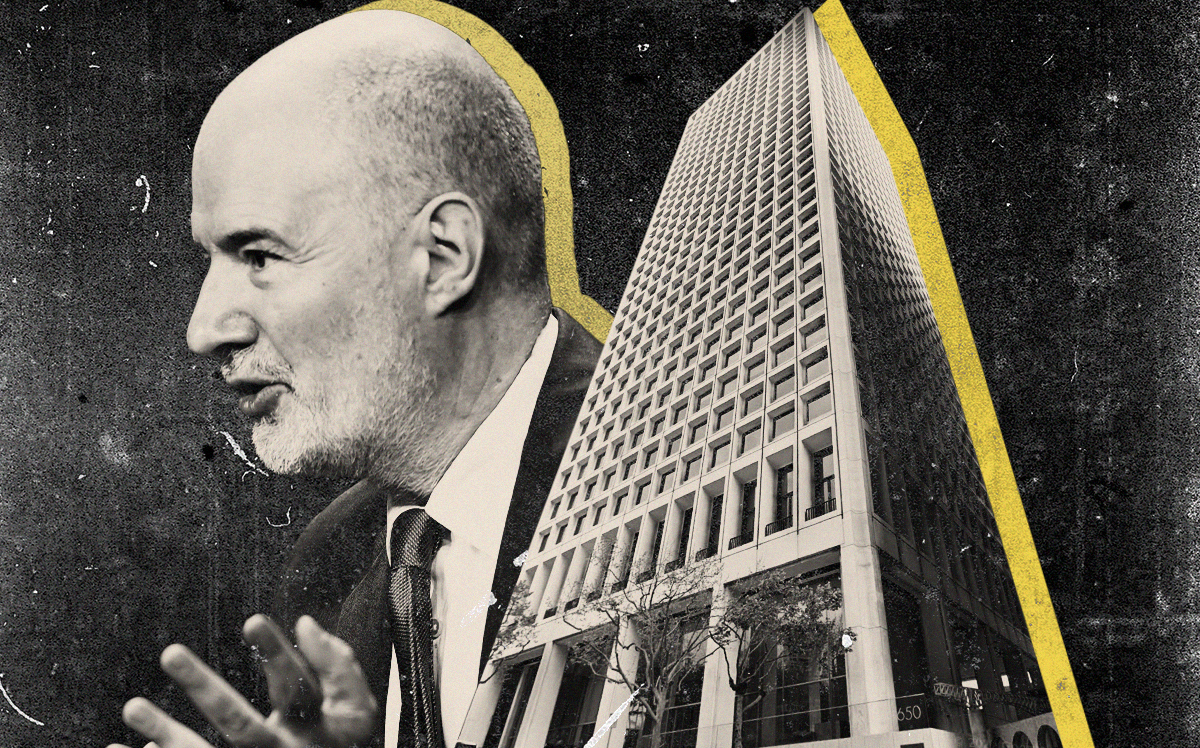 Inside Brookfield’s LA office defaults
Inside Brookfield’s LA office defaults
Trending
Brookfield gives up on DTLA office after defaulting on $1.1B in debt
Landlord faces “double whammy” of rising finance costs and falling tenancy

A photo illustration of Brookfield’s Brian Kingston with 777 South Figueroa Street (left) and 555 West 5th Street (right) (Brookfield, Google Maps)
Brookfield started the year with six office buildings in Downtown Los Angeles. Five months into the year, it has lost two to court-appointed receivers and has defaulted on more than $1.1 billion in debt connected to its L.A. portfolio.
In court documents, the assets Brookfield has lost — the Gas Company Tower and EY Plaza — have been described as Class A, top-tier buildings with rents above the market average. But Brookfield looks at the properties differently.
“We have always focused on quality so 95 percent of what we own are trophy and Class A buildings that continue to see strong demand globally and benefit from the flight to quality,” a Brookfield spokesperson said in an emailed statement when asked about 725 South Figueroa Street, known as EY Plaza.
“While the pandemic has posed challenges to traditional office in certain U.S. markets, this represents a very small percentage of our portfolio,” the spokesperson added, suggesting its office buildings in Downtown L.A. are neither trophy nor Class A.
At a time when office values are plummeting across the country, rising interest rates have made servicing debt more expensive and companies are holding back from big office leases in light of remote work, Brookfield has had to choose which properties it considers trophy assets worth keeping.
“Just because of the quality of the actual building, it’s still Class A,” said a source familiar with the matter. “The question is whether office is a Class A asset.”
Building a portfolio
Brookfield entered the Downtown L.A. office market in 2006, when it bought Trizec Properties for $4.8 billion. With that acquisition, Brookfield scored three buildings — the Bank of America Plaza, EY Plaza and Figueroa at Wilshire.
Seven years later, Brookfield struck again, this time buying MPG Office Trust in a deal valued at more than $2 billion. That buy came with four office buildings — the Wells Fargo Tower, the Gas Company Tower, the KPMG Tower and 777 Tower — and allowed Brookfield to become the largest office owner in DTLA.
“Los Angeles is in the early stages of what I would call this revolution,” Brookfield’s Bert Dezzutti told the Los Angeles Times when the deal was announced. “That’s why we have been so attracted to this deal for so long.”
After the deal closed, Brookfield formed a new publicly traded entity, called Brookfield DTLA Fund Office Trust Investor, which would own six out of the seven office buildings it now had in the central financial district.
At the end of 2013, the portfolio was about 83.5 percent leased, bringing in nearly $144 million in annual rent, according to a report filed with the U.S. Securities & Exchange Commission. Brookfield planned to spend up to $65 million through 2018 to renovate the properties, fixing the roof, elevators and facade work, according to the filing.
Brookfield managed to boost annual rent on a per-square-foot basis to $26.87 in 2019, up 17.5 percent from $22.87 in 2013. But occupancy levels ebbed and flowed.
In 2016, the properties were 87.9 percent leased. Three years later, it was down to 82.9 percent — worse than when Brookfield acquired most of the portfolio.
“Some of the properties of our competitors may be newer, better located or better capitalized than the properties we own,” Brookfield said in its annual report in 2019. “These properties may have vacancy rates higher than our properties, which may result in their owners being willing to make space available at lower prices.”
Giving up
WIth the pandemic, Brookfield was hit hard, impacted by companies shrinking their office footprint in light of remote work.
Occupancy across its portfolio dropped to 79.1 percent at the end of 2020, causing Brookfield to report a drop in annual rent on a year-over-year basis for the first time ever.
And occupancy kept dropping, hitting 77.2 percent at the end of 2021, according to SEC filings. Brookfield did manage to raise annual rents to $28.57 per square foot on an annual basis, but revenues weren’t meeting 2019 levels.
Then interest rates rose — something Brookfield knew could pose issues in the future.
“If we are unable to manage our interest rate risk efficiently, our cash flows and operating results may suffer,” Brookfield said in a 2019 annual report.
Suddenly, the cost of Brookfield’s debt service was soaring, given most of its loans were floating rate and set to expire in 2023, meaning Brookfield would have had to refinance at a higher rate. And it couldn’t bring in tenants to help boost occupancy and rental revenues.
“It’s a double whammy,” said the source familiar with Brookfield. “It’s a 400 to 500 basis point increase in the cost of capital and a different way that corporate America works.”
In February, Brookfield defaulted on $784 million in loans connected to the 52-story Gas Company Tower at 555 West 5th Street and the 52-story 777 Tower at 777 South Figueroa Street.
Then, it defaulted on a $275 million loan connected to EY Plaza, a 41-story tower at 725 South Figueroa Street.
Both EY Plaza and the Gas Company Tower have been placed into separate receiverships, where a court-appointed third party is tasked with recovering as much value for the debt holders as possible, according to court filings.
A receiver can use rental revenue for tenant improvements, marketing the property for lease and make distributions to the lenders on the property — if there’s any left over.
The challenge for a receiver will be convincing new tenants that they should move into the buildings — at a time when about 30 percent of all office space in Downtown L.A. is vacant, according to Savills.
But Brookfield’s decision to walk away from the office buildings suggests Downtown L.A. is no longer attractive to the firm.
“It’s just regular business. It’s small and not relevant to the overall business,” Brookfield Asset Management CEO Bruce Flatt said of the defaults in February.
The company hasn’t walked away from properties in Downtown L.A. altogether. Earlier this month, Brookfield scored a three-year extension on a $58.5 million loan on Figat7th — a 316,000-square-foot retail center at 735 South Figueroa Street — signaling it wants to hold onto the property at least for now.
Read more
 Inside Brookfield’s LA office defaults
Inside Brookfield’s LA office defaults
 PIMCO’s Columbia Property Trust defaults on $1.7B of office loans
PIMCO’s Columbia Property Trust defaults on $1.7B of office loans
 Angelo Gordon, Kawa Capital among investors exposed to Brookfield’s DTLA defaults
Angelo Gordon, Kawa Capital among investors exposed to Brookfield’s DTLA defaults
But for office assets in Downtown L.A., Brookfield has largely given up on its 17-year-long bet.
“It’s building to building,” a source familiar with the properties said of Brookfield’s strategy. “But in some areas they’re saying, ‘We don’t know if we want to be there.’”




